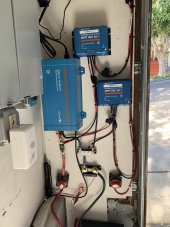erictstahl
New Member
- Joined
- Apr 25, 2021
- Messages
- 27
This is just a proof of concept that I did while stuck in quarantine. It shows how you can build your own micro solar system for trickle charging your Tesla (or anything else). I will add more panels / batteries over time. By the end of the day it added 12 miles of range to to the car / day (4,380 miles/year). It's the middle of January, so I'm curious to see what that gets to in the summer months. I will post an update in a few months.
The trickiest part of was properly grounding the inverter so the Tesla charger would accept it. Watch this video to see how to bond the 120v AV output to the inverter chassis https://youtu.be/ehK0uYNtaIY
Solar: 8 x 100 watt Renogy
Charge Controller: Victron 30 amp, 100 volt
Battery: SOK 206 amp hour
Inverter: Victron Phoenix 1200 watt
Car: 2001 Tesla Model 3 Long Range
Will, thanks for all of the great videos. Even though this is a teeny-tiny system, I had fun making it... and it actually works!?!
Last edited:



